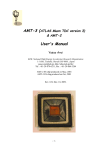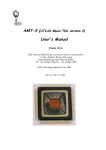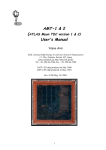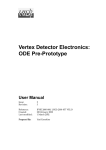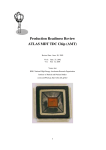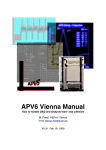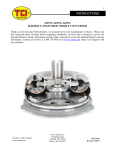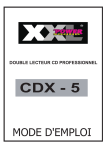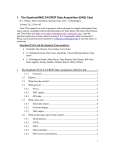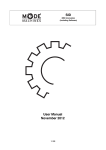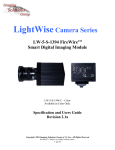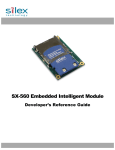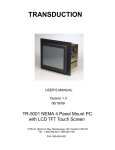Download AMT-1 User's Manual
Transcript
AMT-1 (ATLAS Muon TDC version 1) User's Manual Yasuo Arai KEK, National High Energy Accelerator Research Organization 1-1 Oho, Tsukuba, Ibaraki 305, Japan [email protected], http://atlas.kek.jp/~araiy/ Tel : +81-298-64-5366 Fax : +81-298-64-2580 ES Chip produced on Mar, 2000 Rev. 0.71 Jan. 11, 2001. 1 Contents 0. BUGS AND FUTURE CHANGES......................................................................................................... 4 0.1. 0.2. B UGS........................................................................................................................................... 4 F UTURE C HANGES ......................................................................................................................... 4 1. INTRODUCTION................................................................................................................................ 5 2. CIRCUIT DESCRIPTION.................................................................................................................... 6 2.1. 2.2. 2.3. 2.4. 2.5. 2.6. 2.7. 2.7.1. 2.7.2. 2.7.3. 2.7.4. 2.7.5. 2.7.6. 2.8. 2.9. 2.9.1. 2.9.2. 2.9.3. 2.10. 3. F INE TIME MEASUREMENT .............................................................................................................. 7 C OARSE C OUNTER ......................................................................................................................... 8 C HANNEL B UFFER.......................................................................................................................... 9 ENCODER ..................................................................................................................................... 9 L1 B UFFER. .................................................................................................................................10 TRIGGER MATCHING. ....................................................................................................................10 TRIGGER INTERFACE. .....................................................................................................................12 Encoded trigger and resets.....................................................................................................12 Event count reset ..................................................................................................................13 Bunch count reset. ................................................................................................................13 Global reset.........................................................................................................................13 Trigger ...............................................................................................................................13 Separators...........................................................................................................................14 R EAD-OUT FIFO...........................................................................................................................15 R EAD-OUT INTERFACE. ..................................................................................................................15 Parallel read-out ..................................................................................................................15 Serial read-out .....................................................................................................................16 Packet format.......................................................................................................................16 ERROR MONITORING. .................................................................................................................18 CSR REGISTERS & JTAG ACCESS ..................................................................................................18 3.1. C ONTROL REGISTERS .....................................................................................................................20 3.1.1. CSR0..................................................................................................................................21 3.1.2. CSR1..................................................................................................................................21 3.1.3. CSR2..................................................................................................................................21 3.1.4. CSR3..................................................................................................................................21 3.1.5. CSR4..................................................................................................................................21 3.1.6. CSR5..................................................................................................................................21 3.1.7. CSR6..................................................................................................................................22 3.1.8. CSR7..................................................................................................................................22 3.1.9. CSR8..................................................................................................................................22 3.1.10. CSR9..............................................................................................................................22 3.1.11. CSR10............................................................................................................................23 3.1.12. CSR11............................................................................................................................23 3.1.13. CSR12............................................................................................................................24 3.1.14. CSR13, 14.......................................................................................................................24 3.2. S TATUS REGISTERS ........................................................................................................................25 3.2.1. CSR16................................................................................................................................25 3.2.2. CSR17................................................................................................................................26 3.2.3. CSR18................................................................................................................................26 3.2.4. CSR19................................................................................................................................26 3.2.5. CSR20................................................................................................................................26 3.2.6. CSR21................................................................................................................................26 3.3. JTAG P ORT. ................................................................................................................................26 3.3.1. JTAG controller and instructions ............................................................................................27 3.3.2. Boundary scan registers.........................................................................................................28 3.3.3. ID code register....................................................................................................................30 3.3.4. Control registers..................................................................................................................30 3.3.5. Status registers ....................................................................................................................30 3.3.6. Core registers......................................................................................................................31 2 4. 4.1. TIME ALIGNMENT BETWEEN HITS, CLOCK AND TRIGGER MATCHING ...................................31 EXAMPLE OF OFFSET S ETTING .........................................................................................................33 3 0 . Bugs and Future Changes 0 . 1 . Bugs Following bugs are found in AMT-1 and will be fixed in AMT-2. * Control Parity Error : 'Control Parity Error' (error_flags[7]) bit is prepared to indicate whether SEU (Single Event Upset) is occured or not in the control registers. When you set a value to the control register, control parity error may occur in 50% probability. This occurs only if the JTAG tck cycle is longer than two clock cycle (50ns). In the case when you write the CSR register through CIO lines, this error will occur if the CS (chip Select) signlal width is longer than two clock cycle. * Serial transmitter: In some serial mode, strobe signal is not stable. See Table. 4. 0 . 2 . Future Changes Following changes are planned in AMT-2. * Reset Inputs : This inputs are changed from LVDS signal to CMOS signal inputs. pin 1 : RESETM --> RESETB (negative logic), pin 2 : RESETP --> not defined yet. * LVDS receiver : Design of LVDS recever is changed to low-power version. 4 1 . Introduction The ATLAS Muon TDC version 1 (AMT-1) is a Time to Digital Converter (TDC) designed for the Monitored Drift Tubes (MDT) of the ATLAS muon detector. It is processed in Toshiba 0.3 µm CMOS Sea-of-Gate Technology (TC220G). Basic requirements on the AMT chip were summarized in ATLAS note (MUON-NO-179, May 1997) by J. Christiansen and Y. Arai. Then AMT-0 [1] was designed in a 0.7 µm full custom CMOS process based on the 32 channel TDC for the quick test of front-end electronics and MDT chambers. On the other hand, it was decided to use a Toshiba's 0.3 µm CMOS process for a final production. To develop and test many critical elements in the 0.3 µm process, a TEG (Test Element Group) chip (AMT-TEG, [2])was designed, fabricated and tested successfully at KEK. The AMT-TEG was processed in a new 0.3 µm process which will be used in final mass production. The present AMT-1 design is based on the AMT-0, but many modifications are done since the technology is different and many experience was obtained. A time bin size (~0.78 ns) is obtained using the basic gate delay as the base for the time measurement. This scheme prevents the use of very high speed clocks in the circuit and results in a low power device (~20 mW/channel). The gate delay of CMOS devices normally have very large variations as function of process, voltage, and temperature. In this TDC, a phase locked loop (PLL) circuit is implemented to stabilize the gate delay. Oscillation frequency of the internal ring oscillator is multiplied by two with the PLL, thus generate 80 MHz clock. This oscillator has 16 taps, and time difference of two taps are exactly 1/16 of the clock period. When a hit enters, state of these 16 taps are latched and generate a fine time. The fine time measurement is extended by a 13 bit coarse counter. Although the PLL clock is 80 MHz, most of the logic runs at 40MHz which is same as that of the LHC clock. Each channel can buffer 4 measurements until they can be written into a common 256 words deep level 1 buffer. The individual channel buffers works as small derandomizer buffers before the merging of hit measurements into the common L1 buffer. A trigger matching function can select events related to a trigger. The trigger information consisting of a trigger time tag and an event ID can be stored temporarily in an eight words deep trigger FIFO. Measurements matched to the trigger are passed to a 64 words deep read-out FIFO, or A time window of programmable size is available for the trigger matching to accommodate the time spread of hits related to the same event. Optionally channels with hits in a time window before the trigger can be flagged. The trigger time tag can optionally be subtracted from the measurements so only time measurements relative to the trigger needs to be read out. Accepted data can be read out in a direct parallel format or be serialized at a programmable frequency. 5 Fig. 1. Block diagram of the AMT-1 2 . Circuit Description Fig. 1 shows a block diagram of the AMT-1 chip. There are 24 channels of inputs. Table. 1 summarizes the main features of the AMT-1 chip. 6 Table. 1 AMT-1 MAIN FEATURES (System Clock Frequency is 40 MHz otherwise noted) • Least Time Count • Dynamic range • Integral Non Linearity • Differential Non Linearity • Difference between channels • Stability • Input Clock Frequency • PLL mode • Internal System Clock • No. of Channels 0.78 ns/bit (rising edge) 0.78-100ns/bit (falling edge) RMS = 300 ps (rising edge) ? RMS = 300ps ~ 29ns (falling edges) 13 + 4 = 17 bit (102.4 µsec) Max = +/-80 ps ? Max = +/- 80 ps ? Maximum one time bin < 0.1 LSB ? (3.0 - 3.6 V. 0 - 70 ˚C) 10 - 70 MHz (@ x2 mode) x1, x2, x4 or x8 Input Clock x (PLL mode) / 2 24 Channels • Level 1Buffer • Read-out Buffer • Trigger Buffer 256 words 64 words 8 words • Double Hit Resolution • Max. recommended Hit rate • Hit Input Level <10 ns 500 kHz per channel Low Voltage Differential Signaling (LVDS) Internal 100 Ohm termination. 3.3+-0.3V (< 200 mA) 0 - 85 Deg. Cent 0.3 µm CMOS Sea-of-Gate (Toshiba TC220G) die size: 6 mm x 6 mm 0.5 mm lead pitch, 144 pin plastic QFP • Time Resolution • Supply Voltage • Temperature range • Process • Package 2.1. Fine Time Measurement The original idea of the TDC, which use internal gate delay as a fine time element and stabilize the element with a feedback circuit, was born in 1986 [3]. The chip was called TMC (Time Memory Cell) chip. Initial TMC chip use a DLL (Delay Locked Circuit) technique and then PLL (Phase Locked Loop) technique has been used in recent chips. In the PLL version, we have been using a new kind of voltage controlled ring oscillator, asymmetric ring oscillator (Fig. 2). To obtain <1 ns timing resolution, 16 taps are extracted from the oscillator. Fig. 2 shows a simplified schematics and its timing diagram of the asymmetric ring oscillator. Fig. 2 only shows 8 stages but the actual chip implements 16 stages. The asymmetric ring oscillator was creates equally spaced even number (16) of timing signals. The PLL circuit comprises a phase frequency detector (PFD), a charge pump, a loop filter (LPF), and a voltage-controlled oscillator (VCO; asymmetric ring oscillator in this case). An external capacitor (Cvg) is required in the loop filter. The PLL has "divide by 2, 4, and 8" counter , thus the frequency of the VCO can be either the same or the “multiplied by 2, 4, or 8 ” of the input frequency. The propagation delay of the delay elements that determine the oscillation frequency of the 7 VCO is controlled through a control voltage (VGN). When a hit occurs, the state of the 16 taps (and coarse counter) are latched into a hit register. Fig. 2 (a) Asymmetric ring oscillator, (b) extracted timing signal. 2.2. Coarse Counter The dynamic range of the fine time measurement, extracted from the state of the VCO, is expanded by storing the state of a clock synchronous counter. The hit signal may though arrive asynchronously to the clocking and the coarse counter may be in the middle of changing its value when the hit arrives. To circumvent this problem two count values, 1/2 a clock cycle out of phase, are stored when the hit arrives (Fig. 3). Based on the fine time measurement from the PLL one of the two count values will be selected, such that a correct coarse count value is always obtained. The coarse counter has 13 bits and is loaded with a programmable coarse time offset (the LSB is always 0) at reset. The coarse counter of the TDC will in ATLAS be clocked by the two times higher frequency than the bunch crossing signal thereby the upper 12 bit of the coarse counter becoming a bunch count ID of the measurement. The bunch structure of LHC is not compatible with 8 the natural binary roll over of the 12 bit coarse time counter. The bunch counter can therefore be reset separately by the bunch count reset signal and the counter can be programmed to roll-over to zero at a programmed value. The programmed value of this roll-over is also used in the trigger matching to match triggers and hits across LHC machine cycles. Fig. 3 Phase shifted coarse counters loaded at hit. 2 . 3 . Channel Buffer. Each channel can store 4 TDC measurements before being written into the common L1 buffer. The channel buffer is implemented as a FIFO controlled by an asynchronous channel controller. The channel controller can be programmed to digitize individual leading and/or trailing edges of the hit signal. Alternatively the channel controller can produce paired measurements consisting of one leading edge and the corresponding trailing edge. If the channel buffer is full when a new hit arrives it will be ignored (rejected), but the information of the rejected hit is transferred with next valid hit. If the enable_rejected bit in CSR10 is set, the information of the rejected hit is transferred as soon as the channel buffer is available. For the hits stored in the channel buffers to be written into the clock synchronous L1 buffer a synchronization of the status signals from the channel buffers is performed. Double synchronizers are used to prevent any metastable state to propagate to the rest of the chip running synchronously at 40 MHz. When paired measurements of a leading and a trailing edge is performed the two measurements are taken off the channel buffer as one combined measurement. 2.4. Encoder When a hit has been detected on a channel the corresponding channel buffer is selected, the time measurement done with the ring oscillator is encoded into binary form (vernier time), the correct coarse count value is selected and the complete time measurement is written into the L1 buffer together with a channel identifier. Although the ring oscillator and the coarse counter runs at 80 MHz, the base LHC clock is 40 MHz and bunch number is counted at 40 MHz. Most of logics in the AMT1 are designed to run at 40 MHz. To shift from 80 MHz to 40MHz regime, we would like to define different name to measured 9 time. We call the upper 12 bit of the coarse counter as a ‘coarse time’, and the LSB of the coarse counter plus the vernier time as a ‘fine time’. Thus the coarse time will be equivalent to the bunch count. Fig. 4. Definition of coarse time and fine time. In case a paired measurement of leading and trailing edge has been performed the complete time measurement of the leading edge plus a 8 bit pulse width is written into the L1 buffer. The 8 bit pulse width is extracted from the leading and trailing edge measurement taking into account the programmed roll-over value. The resolution of the width measurement is programmable. In case the pulse width is larger than what can be represented with a 8 bit number the width will be forced to a value of $FF (Hex). When several hits are waiting in the channel buffers an arbitration between pending requests is performed. New hits are only allowed to enter into the active request queue when all pending requests in the queue have been serviced. Arbitration between channels in the active request queue is done with a simple hardwired priority (channel 0 highest priority, channel 23 lowest priority). The fact that new requests only are accepted in the active request queue when the queue is empty enables all channels to get fair access to the L1 buffer. 2.5. L1 Buffer. The L1 buffer is 256 hits deep and is written into like a circular buffer. Reading from the buffer is random access such that the trigger matching can search for data belonging to the received triggers. If the L1 buffer runs full the latest written hit will be marked with a special full flag. When the buffer recovers from being full the first arriving hit will be marked with a full recover flag. These flags are used by the following trigger matching to identify events which may have lost hits because of the buffer being full. 2.6. Trigger Matching. Trigger matching is performed as a time match between a trigger time tag and the time measurements them selves. The trigger time tag is taken from the trigger FIFO and the time measurements are taken from the L1 buffer. Hits matching the trigger are passed to the read-out FIFO. Optionally the trigger time tag can be subtracted from the measurements (enable_relative = 1) such that all time measurements read out are referenced to the time (bunch crossing) when the event of interest occurred. 10 Fig. 5. Trigger latency and trigger window related to hits on channels. There are 3 time counters ; coarse time, trigger time and reject time counters. A match between the trigger and a hit is detected within a programmable time window (Fig. 5) if enable_match is set. The trigger is defined as the coarse time count (bunch count ID) when the event of interest occurred. All hits from this trigger time until the trigger time plus the matching window will be considered as matching the trigger. The trigger matching being based on the coarse time means that the “resolution” of the trigger matching is one clock cycle (40MHz) and that the trigger matching window is also specified in steps of clock cycles. The maximum trigger latency which can be accommodated by this scheme equals half the maximum coarse time count = 2 1 2 /2 = 2048 clock cycles = 51 us. The trigger matching function is capable of working across roll-over in all its internal time counters. For a paired measurement the trigger matching is performed on the leading edge of the input pulse. The search for hits matching a trigger is performed within an extended search window to guarantee that all matching hits are found even when the hits have not been written into the L1 buffer in strict temporal order. For normal applications it is sufficient to make the search window ~8 larger than the match window. The search window should be extended for applications with very high hit rates or in case paired measurements of wide pulses are performed (a paired measurement is not written into the L1 buffer before both leading and trailing edge have been measured). To prevent buffer overflow and to speed up the search time an automatic reject function can reject hits older than a specified limit when no triggers are waiting in the trigger FIFO and enable_auto_reject bit is set. A separate reject counter runs with a programmable offset to detect hits to reject. The trigger matching can optionally search a time window before the trigger for hits which may have masked hits in the match window if enable_mask bit is set. A channel having a hit within the specified mask window will set its mask flag. The mask flags for all channels are in the end of the trigger matching process written into the read-out FIFO if one or more mask flags have been set. In case an error condition (L1 buffer overflow, Trigger FIFO overflow, memory parity error, etc.) has been detected during the trigger matching a special word with error flags is generated if enable_errmark and corresponding enable_error bits are set. All data belonging to an event is written into the read-out FIFO with a header and a trailer if enable_header and enable_trailer bits are set respectively. The header contains an event id and a bunch id. The event trailer contains the same event id plus a word count. The trigger matching function may also be completely disabled (enable_matching = 0) whereby all data from the L1 buffer is passed directly to the read-out FIFO. In this mode the TDC have an 11 effective FIFO buffering capability of 256 + 64 = 320 measurements. An example of setting is shown in 4.1. 2.7. Trigger Interface. The trigger interface takes care of receiving the trigger signal and generate the required trigger time tag to load into the trigger FIFO. In addition it takes care of generating and distributing all signals required to keep the TDC running correctly during data taking. The TDC needs to receive a global reset signal that initializes and clears all buffers in the chip before data taking. A bunch count reset and event count reset is required to correctly identify the event ID and the bunch ID of accepted events. These signals can either be generated separately or be coded on a single serial line at 40 MHz. 2.7.1. Encoded trigger and resets Four basic signals are encoded using three clock periods (Table 1). The simple coding scheme is restricted to only distribute one command in each period of three clock periods. A command is signaled with a start bit followed by two bits determining the command. When using encoded trigger and resets an additional latency of three clock periods is introduced by the decoding compared to the use of the direct individual trigger and resets. Selection between the encoded signals and the direct signals are schematically shown in Fig. 6. Table 1 Encoded signal bit pattern. Meaning bit 210 Trigger 100 Bunch count reset 110 Global reset 101 Event count reset 111 12 Fig. 6. Simplified diagram of the clock, reset and trigger signals. 2.7.2. Event count reset An event count reset loads the programmed event_count_offset into the event ID counter. In addition a separator can be injected into the L1 buffer and the trigger FIFO if enable_sepa_evrst is set. 2.7.3. Bunch count reset. The bunch count reset loads the programmed offsets into the coarse time counter, the trigger time tag (bunch id) counter and the reject counter. In addition a separator can be injected into the L1 buffer and the trigger FIFO if enable_sepa_bcrst is set. From a bunch count reset is given to the TDC until this is seen in the hit measurements themselves, a latency of the order of 2 clock cycles is introduced by internal pipelining of the coarse time counter. The definition of time 0 in relation to the bunch count reset is described in more detail in section 4. 2.7.4. Global reset. The global reset generate master_reset signal if enable_mreset_code is set (see Fig. 6). The master_reset clears all buffers in the TDC and initializes all internal state machines to their initial state. Before data taking an event count reset and a bunch count reset must also have been issued. As shown in Fig. 6, decoder circuit, CSR, JTAG contrioller and PLL circuit are not reset by the master_reset. 2.7.5. Trigger The basis for the trigger matching is a trigger time tag locating in time where hits belong to an event of interest. The first level trigger decision must be given as a constant latency yes/no trigger 13 signal. The trigger time tag is generated from a counter with a programmable offset. When a trigger is signaled the value of the bunch counter (trigger time tag) is loaded into the trigger FIFO. The effective trigger latency using this scheme equals the difference between the coarse_time_offset and the bunch_count_offset. Fig. 7. Generation of trigger data. If the trigger FIFO runs full the trigger time tags of following events will be lost. The trigger interface keeps track of how many triggers have been lost so the event synchronization in the trigger matching and the DAQ system is never lost (enable_trfull_reject = 1). For each event with a lost trigger time tag the trigger matching will generate an event with correct event id and a special error flag signaling that the whole event has been lost. 2.7.6. Separators The TDC is capable of running continuously even when bunch count resets and event count resets are issued. Matching of triggers and hits across bunch count resets (different machine cycles) are handled automatically if the correct roll-over value have been programmed. Alternatively it is possible to insert special separators in the trigger FIFO and the L1 buffer when a bunch count reset or an event count reset have been issued (enable_sepa_bcrst or enable_sepa_evrst). These will make sure that hits and triggers from different event count or bunch count periods (machine cycles) never are mixed. In this mode it is not possible to match hits across bunch count periods. This separator can be readout if enable_sepa_readout bit is set. This mechanism is conceptually shown in Fig. 8. 14 Fig. 8 Conceptual view of the separator insertion and matching. 2.8. Read-out FIFO. The read-out FIFO is 64 words deep and its main function is to enable one event to be read out while another is being processed in the trigger matching. If the read-out FIFO runs full there are several options of how this will be handled. Back propagate (enable_rofull =0, enable_l1full_reject = 0, enable_trfull_reject = 0 ): The trigger matching process will be blocked until new space is available in the read-out FIFO. When this occurs, the L1 buffer and the trigger FIFO will be forced to buffer more data. If this situation is maintained for extended periods the L1 buffer or the trigger FIFO will finally become full and the measurement is stopped. Nearly full reject: In this mode the trigger matching will be blocked if either the L1 buffer (enable_l1full_reject = 1) or the trigger FIFO is nearly full (enable_trfull_reject = 1). If this occurs event data will be rejected to prevent the L1 buffer and the trigger FIFO to overflow. The event header and event trailer data will never be rejected as this would mean the loss of event synchronization in the DAQ system. Any event which have lost data in this way will be marked with an error flag. Reject (enable_rofull_reject =1 ): As soon as the read-out FIFO full, event data (not event headers and trailers) will be rejected. Any loss of data will be signaled with an error flag. 2.9. Read-out Interface. All accepted data from the TDC can be read out via a parallel or serial read-out interface in words of 32 bits. The event data from a chip typically consists of a event header (if enabled), accepted time measurements, mask flags (if enabled), error flags (if any error detected for event being read out) and finally a event trailer (if enabled). 2.9.1. Parallel read-out Read out of parallel data from the TDC is enabled by setting enable_serial=0 and performed via a clock synchronous bus. Several TDC’s may share one read-out bus, and each TDC will be selected with CS (chip select) and DSPACE (data space) signals. 15 The read out of individual hits are controlled by a DREADY (data ready) / GETDATA (get data) handshake. If the GETDATA signal is constantly held active (independent of DREADY) it is interpreted as the read-out can be performed at the full speed of the TDC. The effective read-out speed can be slowed down by using the DREADY / GETDATA handshake protocol to introduce wait cycles. The number of clock periods that the GETDATA signal is asserted is used to determine the word count for the event available in the global trailer. 2.9.2. Serial read-out The accepted TDC data can be transmitted serially over twisted pairs using LVDS signals by setting enable_serial = 1. Data is transmitted in words of 32 bits with a start bit set to one and followed by a parity bit and a stop bit. When no data is transmitted the serial data and clock lines are kept at zero. The serialization speed is programmable from 80 to 10 Mbits/s. Serial clock Serial data start bit 31 bit 30 bit 1 bit 0 parity stop Fig. 9 :Serial frame format with start bit and parity bit In addition to the serialized data an LVDS pair can carry strobe information in a programmable format as shown in Fig. 9. Leading Strobe: Direct serializing clock to strobe data on rising edge. DS Strobe : DS strobe format as specified for transputer serial links. DS strobe only changes value when no change of serial data is observed. For each format, there are two modes , one is continuous strobe regardless of data existance, another mode generate strobe signal only when data is available. Fig. 9. Different strobe types. 2.9.3. Packet format Data read out of the TDC is contained in 32 bits data packets. For the parallel read-out mode one complete packet (word) can be read out in each clock cycle. In the serial read-out mode a packet is sent out bit by bit. The first four bits of a packet are used to define the type of data packet. 16 The following 4 bits are used to identify the ID of the TDC chip (programmable) generating the data. Only 7 out of the possible 16 packet types are defined for TDC data. The remaining 9 packet types are available for data packets added by higher levels of the DAQ system. TDC header: Event header from TDC 31 30 29 28 27 26 25 24 23 22 21 20 19 18 17 16 15 14 13 12 11 10 9 8 7 6 5 4 3 2 1 0 1 0 1 0 TDC ID Event ID Bunch ID TDC: Programmed ID of TDC. Event ID: Event ID from event counter. Bunch ID: Bunch ID of trigger (trigger time tag). TDC trailer: Event trailer from TDC 31 30 29 28 27 26 25 24 23 22 21 20 19 18 17 16 15 14 13 12 11 10 9 8 7 6 5 4 3 2 1 0 1 1 0 0 TDC ID Event ID Word Count Word count: Number of words from TDC (incl. headers and trailers). Mask flags: Channel flags for channels having hits with in mask window 31 30 29 28 27 26 25 24 23 22 21 20 19 18 17 16 15 14 13 12 11 10 9 0 0 1 0 TDC ID Mask flags 8 7 6 5 4 3 2 1 0 Mask flags: Channels flagged as having hits with in mask window. Single measurement: Single edge time measurement 31 30 29 28 27 26 25 24 23 22 21 20 19 18 17 16 15 14 13 12 11 10 9 8 7 6 5 4 3 2 1 0 0 0 1 1 TDC ID Channel T E Coarse Time Fine Time Channel: TDC channel number. Coarse Time: Coarse time measurement (in bins of 25ns). Fine Time: Fine time measurement from PLL (in bins of 25ns/32). T: Edge type: 1 = leading edge, 0 = trailing edge. E: Hit error. An error has been detected in the hit measurement (a coarse error, a channel select error, or a l1 buffer error) Combined measurement: Combined measurement of leading and trailing edge 31 30 29 28 27 26 25 24 23 22 21 20 19 18 17 16 15 14 13 12 11 10 9 8 7 6 5 0 1 0 0 TDC ID Channel Width Coarse Time 4 3 2 1 0 Fine Time Width: Width of pulse in programmed time resolution (CSR9 width_select). If the pulse width excees the width range, the width will be $FF. Coarse Time: Coarse time measurement of leading edge relative to trigger (in bins of 25ns). Fine Time: Fine time measurement of leading edge (in bins of 25ns/32). Errors: Error flags sent if an error condition have been detected 31 30 29 28 27 26 25 24 23 22 21 20 19 18 17 16 15 14 13 12 11 10 9 0 1 1 0 TDC ID - 8 7 6 5 4 3 2 1 0 Error flags Error flags: see Table. 2 and CSR16. Debugging data: Additional information for system debugging Separator 31 30 29 28 27 26 25 24 23 22 21 20 19 18 17 16 15 14 13 12 11 10 9 0 1 1 1 TDC ID 0 0 0 0 - 8 7 6 5 4 Bunch ID 3 2 1 0 Bunch ID: Trigger time tag counter when separator was generated. Buffer Occupancy 31 30 29 28 27 26 25 24 23 22 21 20 19 18 17 16 15 14 13 12 11 10 9 8 7 6 5 4 3 2 1 0 0 1 1 1 TDC ID 0 0 0 1 R L1 Occupancy L1 occupancy: L1 buffer occupancy. 17 R: Read-out FIFO full. 2.10. Error monitoring. All functional blocks in the TDC are continuously monitored for error conditions. Memories are continuously checked with parity on all data. All internal state machines have been implemented with a “one hot” encoding scheme and is checked continuously for any illegal state. The JTAG instruction register have a parity check to detect if any of the bits have been corrupted during down load. The CSR control registers also have a parity check to detect if any of the bits have been corrupted by a Single Event Upset (SEU). The error status of the individual parts can be accessed via the CSR status registers. Table. 2. Description of Errors Flags Error bit# Description Coarse error 0 A parity error in the coarse count has been detected in a channel buffer. Channel select error 1 A synchronization error has been detected in the priority logic used to select the channel being written into the L1 buffer. L1 buffer error 2 Parity error detected in L1 buffer. Trigger FIFO error 3 Parity error detected on trigger FIFO. Matching state error 4 Illegal state detected in trigger matching logic. Read-out FIFO error 5 Parity error detected in read-out FIFO. Read-out state error 6 Illegal state detected in read-out logic. Control parity error 7 Parity error detected in control registers. JTAG error 8 Parity error in JTAG instruction. Any detected error condition in the TDC sets its corresponding error status bit. The error bits are reset by a global reset or error_reset (CSR0[10]). The error bits are also reset by bunch count reset or event count reset if enable_errrst_bcrevr is set. All the available error flags are OR-ed together with individual programmable mask bits to generate an ERROR signal. When the ERROR signal becomes active the TDC can respond following ways: Ignore: No special action will be performed Mark events: All events being generated after the error has been detected will be marked with a special error flag. 3 . CSR Registers & JTAG access There are two kinds of 12 bits registers, "CONTROL" and "STATUS" registers. The "CONTROL" registers are readable and writable registers which control the chip functionality. The "STATUS" registers are read only registers which shows chip statuses. There are 15 Control registers (CSR0-14) and 6 Status registers (CSR16-21). These registers are accessible from 12 bit bus (DIO[11:0]) or through JTAG interface. 18 Fig. 10. Structure of JTAG - CSR registers. 19 3 . 1 . Control registers Table. 3. Bit assignment of the control registers. 11 10 9 8 CSR0 global_r error_ disable_ enable_ eset reset encode errrst_ (0) (0) (0) bcrevr {11} {10} {9} (0) {8} CSR1 CSR2 CSR3 CSR4 CSR5 CSR6 CSR7 CSR8 CSR9 BIT 7 6 5 4 3 2 1 0 test_ test_ enable_ disable_ clkout_mode pll_multi mode invert direct ringosc (0) (0) (0) (0) (0) (0) {7} {6} {5} {4} {3:2} {1:0} mask_window (0) {23:12} search_window (0) {35:24} match_window (0) {47:36} reject_count_offset (0) {59:48} event_count_offset (0) {71:60} bunch_count_offset (0) {83:72} coarse_time_offset (0) {95:84} count_roll_over (FFF) {107:96} width_select tdc_id (0) (0) (0) {:115:113} {112} {111:108} enable_ enable_ enable_ enable_ enable_ enable_ enable_ enable_ relative serial header trailer rejected pair trailing leading strobe_select readout_speed (1) (0) {119:118} {117:116} CSR10 enable_ enable_ enable_ enable_ auto_ l1occup match mask reject _readout (1) (0) (1) (0) (0) (0) (0) (0) (0) {131} {130} {129} {128} {127} {126} {125} {124} {123} CSR11 enable_ enable_ enable_ enable_ enable_ enable_ enable_ enable_ enable_ rofull_ l1full_ trfull_ errmark mark_ ermark_ errmark l1ovr mreset_ reject reject reject rejected rejected _ovr _detect code (0) (0) (0) (0) (0) (0) (0) (0) (0) {143} {142} {141} {140} {139} {138} {137} {136} {135} CSR12 enable_ enable_ enable_ enable_ sepa_ sepa_ sepa_ error readout bcrst evrst (0) (0) (0) (1FF) {155} {154} {153} {152:144} CSR13 enable_channel[11:0] (FFF) {167:156} CSR14 enable_channel[23:12] (FFF) {179:168} CSR15 (not used) () -- initial value at reset. {} – JTAG bit No. 20 (0) {122} enable_ resetcb_ sepa (0) {134} (0) {121} enable_ mreset_ evrst (0) {133} (1) {120} enable_ setcount _bcrst (0) {132} 3.1.1. CSR0 pll_multi[1:0] : The frequency ration between the external clock and the internal ring oscillator frequency is determined by these bits as shown below. pll_multi[1] pll_multi[0] Input frequency : Synthesized frequency 0 0 1:2 0 1 1:4 1 0 1:8 1 1 1:1 clkout_mode[1:0] : CLKOUT pin mode. 0 -- Start_Sync : Synchronized output of the START signal. 1 -- 40MHz clk : PLL clock / 2 output. This is the system clock used in most of logics. 2 -- 80 MHz clk : PLL clock outpuut. 3 -- Coarse Counter Carry. : Carry outout of the Coarse Counter. This can be used to extend the time range. disable_ringosc : Stop the oscillation of the ring oscillator and disable charge pump circuit of the PLL. enable_direct : enable direct input pins. 0 --- trigger/reset signals are came from encoded input (encontp/enccontm), 1 --- trigger/reset signals are came from direct input pins (trigp/trigm, bunchrstp/bunchrstm, eventrstp/eventrstm). test_invert : automatic inversion of test pattern in test mode. test_mode : enable test mode. enable_errrst_bcrevr : enable error reset when bunch count reset or event count reset is came. disable_encode : disable fine time encoder and output 111. error_reset : clear error bits in CSR16[8:0]. global_reset : Global reset of the TDC. 3.1.2. CSR1 mask_window[11:0] mask window in number of clock cycles 3.1.3. CSR2 search_window[11:0] search window in number of clock cycles 3.1.4. CSR3 match_window[11:0] matching window in number of clock cycles 3.1.5. CSR4 reject_count_offset[11:0] rejection counter offset 3.1.6. CSR5 event_count_offset[11:0] event number offset 21 3.1.7. CSR6 bunch_count_offset[11:0] trigger time tag counter offset 3.1.8. CSR7 coarse_time_offset[11:0] coarse time counter offset 3.1.9. CSR8 count_roll_over[11:0] 3.1.10. counter roll over value CSR9 tdc_id[3:0] TDC identifier. This ID is attached to the output data. width_select[2:0] : Set pulse width resolution in pair measurement. width select width output resolution(*) max. width(*) 0 full_width[7:0] 0.78125 ns 200 ns 1 full_width[8:1] 1.5625 ns 400 ns 2 full_width[9:2] 3.125 ns 800 ns 3 full_width[10:3] 6.25 ns 1.6 µs 4 full_width[11:4] 12.5 ns 3.2 µs 5 full_width[12:5] 25 ns 6.4 µs 6 full_width[13:6] 50 ns 12.8 µs 7 full_width[14:7] 100 ns 25.6 µs (*) at 40 MHz clock. readout_speed[1:0] : 0 -- 40 Mbps, 1 -- 20 Mbps, 2 -- 10 Mbps, 3 -- 80 Mbps. strobe_select[1:0] : 0 -- gated DS strobe, 1 -- continuous DS strobe, 2 -- gated leading edge, 3 -- continuous leading edge. (caution: some of the transfer mode are unstable in present chip as show below.) 22 Table. 4. Unstable serial modes. strobe speed comments 0 0 1 2 3 0 1 2 3 0 1 2 3 0 1 2 3 OK OK OK OK (2 stop bits) OK OK OK unstable strobe 1 cycle ahead strobe 1/2 cycle ahead strobe 1/4 cycle ahead strobe none strobe unstable strobe unstable strobe unstable OK 1 2 3 3.1.11. CSR10 enable_leading enable leading edge measurement. enable_trailing enable trailing edge measurement enable_pair enable pair (leading and trailing edge) measurement. If this bit is set, enable_leading and enable_trailing bits are masked. enable_rejected enable force generation of rejected hit. (see section 2.3) enable_trailer enable trailer in read-out data. enable_header enable header in read-out data. enable_serial enable serial read-out (otherwise parallel read-out) enable_relative enable read-out of relative time to trigger time tag enable_mask enable search and read-out of mask flags enable_match enable trigger matching enable_l1occup_readout enable read-out of l1 occupancy for each event (use for debugging) enable_auto_reject enable of automatic rejection (see section 2.6) 3.1.12. CSR11 enable_setcount_bcrst enable all time counters to be reset on bunch count reset enable_mreset_evrst enable master reset on event reset enable_resetcb_sepa enable channel buffer reset when a separator is inserted enable_mreset_code enable master reset from global reset of the encoded_control 23 enable_l1ovr_detect enable l1 buffer overflow detection enable_errmark_ovr enable error marking events with overflow enable_errmark_rejected enable error mark event if rejected seen during matching enable_mark_rejected enable special marker word for rejected hits enable_errmark mark all events with error word if internal error exists. enable_trfull_reject enable event data rejection if trigger FIFO nearly full (see section 2.8) enable_l1full_reject enable event data rejection if L1 buffer nearly full (see section 2.8) enable_rofull_reject enable event data rejection when read-out FIFO full (see section 2.8) 3.1.13. CSR12 enable_error[8:0] ERROR signal is asserted if corresponding enable_error bit is set. enable_sepa_evrst enable generate separator on event reset enable_sepa_bcrst enable generate separator on bunch count reset enable_sepa_readout enable read-out of internal separators (debugging) 3.1.14. CSR13, 14 enable_channel[23:0] enable individual channel inputs 24 3 . 2 . Status registers Table. 5. Bit assignment of the status registers (all these registers are read only). CSR16 CSR17 CSR18 11 rfifo_ empty (1) {11} l1_ empty (1) {23} tfifo_ empty (1) {35} CSR19 coarse_ counter [0] (0) {47} CSR20 CSR21 10 rfifo_ full (0) {10} l1_ nearly_ full (0) {22} tfifo_ nearly_ full (0) {34} 9 8 control_ parity (1) {9} l1_ l1_ over_ over recover flow (1) (0) {21} {20} tfifo_ running full 7 6 5 4 error_ flags (0) {8:0} 3 2 l1_ write_address (0) {19:12} l1_ read_address (0) (0) {33} {32} tfifo_ occupancy (0) {46:44} (0) {31:24} l1_ start_address (0) {43:36} 0 0 0 0 0 (0) {71} (0) {70} (0) {69} (0) {68} (0) {67} coarse_counter[12:1] (0) {59:48} 0 (0) {66} () -- initial value at reset. {} --- JTAG bit No. 3.2.1. CSR16 error_flags[8:0] : status of error monitoring. (see section 2.10) bit # 0: coarse error (parity error in the coarse counter) 1: channel select error (more than 1 channel are selected) 2: l1 buffer parity error 3: trigger FIFO parity error 4: trigger matching error (state error) 5: readout FIFO parity error 6: readout state error 7: control parity error 8: JTAG instruction parity error control_parity parity of control data (see section 2.10) rfifo_full[0] read-out FIFO full rfifo_empty[0] read-out FIFO empty 25 rfifo_ occupancy[5:0} (0) {65:60} 1 0 3.2.2. CSR17 l1_write_address[7:0] L1 buffer write address. l1_overflow L1 buffer overflow bit l1_over_recover L1 buffer overflow recover bit l1_nearly_full L1 buffer nearly full bit l1_empty L1 buffer empty bit 3.2.3. CSR18 l1_read_address[7:0] L1 buffer read address running status of START signal tfifo_full trigger FIFO full bit tfifo_nearly_full trigger FIFO nearly full bit trigger_fifo_empty trigger FIFO empty bit 3.2.4. CSR19 l1_start_address L1 buffer start address tfiffo_occupancy trigger FIFO occupancy (number of word in trigger FIFO) coarse_counter Coarse counter bit 0 3.2.5. CSR20 coarse_counter[12:1] Coarse counter bit [12:1] 3.2.6. CSR21 rfifo_occupancy[5:0] Read-out FIFO occupancy (number of word in read-out FIFO) 3 . 3 . JTAG Port. JTAG (Joint Test Action Group, IEEE 1149.1 standard) boundary scan is supported to be capable of performing extensive testing of TDC modules while located in the system. Testing the functionality of the chip itself is also supported by the JTAG INTEST and BIST capability. In addition special JTAG registers have been included in the data path of the chip to be capable of performing effective testing of registers and embedded memory structures. Furthermore, it is also possible to access the CSR registers from the JTAG port. JTAG TAP (Test Access Port) state diagram is shown in Fig. 11. 26 Fig. 11 JTAG TAP controller state diagram. Numbers in each states shown are state variable of the TAP controller. 3.3.1. JTAG controller and instructions The JTAG instruction register is 4 bits long plus a parity bit: [3:0] ins[3:0] JTAG instruction [4] parity[0] parity of JTAG instruction 27 Table. 6. JTAG Instructions. Parity Instruction: Name Description 0 0000: EXTEST. Boundary scan for test of inter-chip connections on module. 1 0001: IDCODE. Scan out of chip identification code. 1 0010: SAMPLE. Sample of all chip pins via boundary scan registers. 0 0011: INTEST. Using boundary scan registers to test chip itself. - 0100 - 0111: (not used) 1 1000: CONTROL. Read/Write of control data. 0 1001: (not used) 0 1010: STATUS. Read out of status register information. 1 1011: CORETEST. Read/Write internal registers for debugging. 0 1100: BIST. Built In Self Test for Memories. - 1101 - 1110: (not used) 0 1111 BYPASS. Select BYPASS register. 3.3.2. Boundary scan registers. All signal pins of the TDC are passed through JTAG boundary scan registers. All JTAG test modes related to the boundary scan registers are supported (EXTEST, INTEST, SAMPLE). 28 Table. 7. Boundary Scan Registers. BSR # 0 1 2:25 26 27 28 29 30 31 32 : 53 54 55:74 75 76 77 78 79 80:84 85 86 87 88 89 Pin name RESETP, RESETM ENCCONTP, ENCCONTM HITP[0:23], HITM[0:23] BUNCHRSTP, BUNCHRSTM EVENTRSTP, EVENTRSTM TRIGP, TRIGM CLKP, CLKM DIOEN do[0] di[0] : do[11] di[11] do[12: 31] GETDATA START DSPACE WR CS RA[0:4] CLKOUT DREADY ERROR SERIOUTP, SERIOUTM STROBEP, STROBEM Input/Output I I Comment LVDS input LVDS input I LVDS input I LVDS input I LVDS input I I I O I : O I O I I I I I I O O O O LVDS input LVDS input O LVDS output see Fig. 12 see Fig. 12 see Fig. 12 see Fig. 12 see Fig. 12 LVDS output 29 Fig. 12. JTAG boundary scan circuit for the DIO port. 3.3.3. ID code register A 32 bit chip identification code can be shifted out when selecting the ID shift chain. [0] [11:1] [27:12] [31:28] Start bit = 1, manufacturer code =✣✣✣✤✔✣✣✤✤✔✣✣✣✔✜✻os❉❊❃❂✔✰o.✢, TDC part code decimal = 1000 1011 1000 0011 (assignd by Toshiba) Version code 0001 Thus the total ID code in hex format is '18B83131'. 3.3.4. Control registers The JTAG control scan path is used to set CSR0-14 registers that should not be changed while the TDC is actively running. See section 3.1 for register details. 3.3.5. Status registers The JTAG status scan path is used to get access to the status of the TDC while it is running (or after a run). See section 3.2 for register details. 30 3.3.6. Core registers The JTAG core register scan path is used to perform extended testing of the TDC chip. This scan path gives direct access to the interface between the channel buffers and first level buffer logic. It is used in connection with the test_mode bits and is only intended for verification and production tests of the TDC chip. Table. 8. Bit assignment of the core registers. JTAG bit # name R/W comments [10:0] matching_state[10:0] R monitoring of trigger matching state [37:11] trigger_data[26:0] R monitoring of active trigger data (*) [38] trigger_ready R monitoring of active trigger [74:39] l1_data[35:0] R monitoring of hit data to trigger matching (*) [75] l1_empty R monitoring of l1_empty flag [76] [168:77] l1_data_ready hit_data[91:0] R R/W monitoring of l1_data_redy flag monitoring/generation of hit_data (*) [173:169] [174] hit_channel[4:0] hit_select_error R/W R/W monitoring/generation of hit_channel monitoring/generation of hit_select_errort [175] hit_load R/W monitoring/generation of hit_load (*) see Appendix A for internal format. matching_state[10:0] : state_waiting state_write_event_header state_write_occupancy state_active state_write_mask_flags state_write_error state_write_event_trailer state_generating_lost_event_header state_generating_lost_event_trailer state_waiting_for_separator state_write_separator 00000000001 00000000010 00000000100 00000001000 00000010000 00000100000 00001000000 00010000000 00100000000 01000000000 10000000000 4 . Time alignment between hits, clock and trigger matching The TDC contains many programmable setups which have effects on the performed time measurements and their trigger matching. The main time reference of the TDC is the clock and the bunch reset which defines the T0 time. The time alignment can basically be divided into three different areas as shown in the figure below. A: Time relationship between the hits, clock and the bunch count reset generating the basic timing measurements of the TDC. B: Time relationship between the performed time measurements and the trigger time tag. C: Time relationship between the time measurements and the automatic reject. 31 Fig. 12 :Time alignment between hits, trigger and automatic reject A. Basic time measurement. As previously stated the basic time reference of the TDC measurements is the rising edges of the clock. The bunch count reset defines the T0 reference time where the coarse time count is loaded with its offset value. The TDC also contains internal delay paths of the clock and its channel inputs which influences the actual time measurement obtained. These effects can be considered as a time shift in relation to the ideal measurement. The time shifts of individual channels may be slightly different but care has been taken to insure that the channel differences are below the bin size (~1 ns) of the TDC. The time shift of the measurements also have some variation from chip to chip and variations with supply voltage and temperature. These variations have also been kept below the bin size of the TDC by balancing the delay paths of the clock and the channels. In Fig. 13, a hit signal is defined such that the time measurement equals zero (coarse_time_offset = 0). The delay from the rising edge of the clock where the bunch reset signal was asserted to the rising edge of the hit signal is for a typical chip 5 5 n s (two clock periods plus 5 n s). Fig. 13 Definition of reference time measurement. B. Alignment between coarse time count and trigger time tag. To perform an exact trigger matching the basic time measurement must be aligned with the positive trigger signal taking into account the actual latency of the trigger decision. The effective trigger latency in number of clock cycles equals the difference between the coarse time offset and the 32 bunch count offset. The exact relation ship is: latency = (coarse_time_offset - bunch_count_offset) modulus (21 2 ). A simple example is given to illustrate this: A coarse_time_offset of 100 Hex (decimal 256) and a bunch_count_offset of 000 Hex gives an effective trigger latency of 100 Hex (decimal 256). Normally it is preferable to have a coarse time offset of zero and in this case the trigger count offset must be chosen to (000 Hex - 100 Hex) modulus (21 2 ) = F00 Hex. C. Alignment between trigger time tag and reject count offset. The workings of the reject counter is very similar to the trigger time tag counter. The difference between the course time counter offset and the reject counter offset is used to detect when an event has become older than a specified reject limit. The rejection limit expression is (coarse_time_offset reject_count_offset) modulus (21 2 ). The rejection limit should be set equal to the trigger latency plus a small safety margin. In case the extraction of masking hit flags are required the reject limit should be set larger than the trigger latency + masking window + safety margin. For a trigger latency of 100 Hex (same as in example in the section above) a reject limit of 108 Hex can be considered a good choice (no mask detection). This transforms into a reject count offset of EF8 Hex when a coarse time offset of zero is used. 4.1. Example of Offset Setting In the LHC experiments there are 3564 clock cycles (88.924 usec/24.9501 ns) in a beam revolution. Thus the count_roll_over (csr8) should be set 3563 ( 'deb' in hex). For the trigger latency of 3 usec (120 clock), bunch_count_offset should be set to 3564 - 120 = 3444. This is summarized in Table. 9. Table. 9 An example of register value setting. Assumptions: number of clock cycles per beam revolution (CC) = 3564 cycles trigger latency (TL) = 120 cycles (3 µsec) maximum drift time (DT) = 32 cycles (800 ns) register name equation value csr1 mask_window >= DT 32 ($20) csr2 search_window >= match_window + 8 40 ($28) csr3 match_window >= DT 32 ($20) csr4 reject_count_offset <= CC -TL -8 csr5 event_count_offset csr6 bunch_count_offset csr7 coarse_time_offset csr8 count_roll_over (*) 3400 ($D48) 0 = CC - TL 3444 ($D74) 0 = CC -1 3563 ($DEB) (*) At present design, count_roll_over must be greater than ($800+search_window). If the bunch count reset signal is applied in each cycle, you can assume larger value for CC, such as CC = 4096. ' xxx_window' indicates window size, so all these parameter is positive value. 0x001 means 1 clock tick window and 0xFFF means 4095 clock tick window. 33 ' xxx_offset' indicates relative time between each counters. These offset is loaded into respective counters when bunch count reset is asserted. All counters are roll over at value ' count_roll_over'. Thus larger value than ' count_roll_over' has no meaning for the window size and the offsets. 34 Appendix A : Internal Data Format Channel Buffer [first data] 45 44 43 42 41 40 rejected edge coarse2 parity ... 32 31 3 0 29 coarse2 coarse1 parity ... 75 28 27 26 ... 18 17 1 6 15 14 13 coarse1 ... 3210 vernier [second data] 91 90 89 88 87 86 rejected edge coarse2 parity 74 75 7 6 coarse2 74 73 72 coarse1 parity ... 60 61 6 2 61 60 59 coarse1 ... 44 45 4 6 vernier if enable_pair = 0 : edge = 0 (trailing edge), edge = 1 (leading edge), if enable_pair = 1 : edge = 0 (trailing edge found), edge = 1 (trailing edge not found) Level 1 Buffer 35 34 33 32 parity make_ separator_ stored buffer_ overflow overflow [enable_pair = 0] 31 30 29 28 27 26 2 5 24 23 22 21 20 19 1 8 17 16 15 14 13 12 11 10 9 8 7 6 5 4 3 2 1 0 hit_error reject_out channel 0 edge edge time [enable_pair =1, normal data] 31 30 29 28 27 26 2 5 24 23 22 21 20 19 18 1 7 16 15 14 13 12 11 10 9 8 7 6 5 4 3 2 1 0 hit_error reject_out channel width leading edge time [enable_pair =1, over_flow] 31 30 29 28 27 26 2 5 24 23 22 21 20 19 18 1 7 16 15 14 13 12 11 10 9 8 7 6 5 4 3 2 1 0 hit_error reject_out channel 11111111 leading edge time [enable_pair =1, under_flow] 31 30 29 28 27 26 2 5 24 23 22 21 20 19 18 1 7 16 15 14 13 12 11 10 9 8 7 6 5 4 3 2 1 0 hit_error reject_out channel 00000000 leading edge time Readout FIFO Event Header 28 27 26 25 24 23 22 21 20 19 18 17 16 15 14 13 12 11 10 9 8 7 6 5 4 3 2 1 0 parity 1 0 1 0 trigger_data[23:0] 35 Lost Event Header 28 27 26 25 24 23 22 21 20 19 18 17 16 15 14 13 12 11 10 9 8 7 6 5 4 3 2 1 0 parity 1 0 1 0 lost_trigger[11:0] trigger_data[11:0] Event Trailer 28 27 26 25 24 23 22 21 20 19 18 17 16 15 14 13 12 11 10 9 8 7 6 5 4 3 2 1 0 parity 1 1 0 0 trigger_data[23:0] Lost Event Trailer 28 27 26 25 24 23 22 21 20 19 18 17 16 15 14 13 12 11 10 9 8 7 6 5 4 3 2 1 0 parity 1 1 0 0 lost_trigger[11:0] 0 Error 28 27 26 25 24 23 22 21 20 19 18 17 16 15 14 13 12 11 10 9 8 7 6543210 parity 0 1 1 0 0 error_data Mask Flags 28 27 26 25 24 23 22 21 20 19 18 17 16 15 14 13 12 11 10 9 8 7 6 5 4 3 2 1 0 parity 0 0 1 0 mask_flags[23:0] Single Measurement (enable_relative =0) 28 27 26 25 24 23 22 21 20 19 18 17 16 15 14 13 12 11 10 9 8 7 6 5 4 3 2 1 0 parity 0 0 1 1 0 T E l1_data[16:0] E : Hit Error = l1_data[31] | l1_data[30] T : Edge Type = l1_data[17] Single Measurement (enable_relative =1) 28 27 26 25 24 23 22 21 20 19 18 17 16 15 14 13 12 11 10 9 8 7 6 5 43210 parity 0 0 1 1 l1_data[29:25] T E coarse_relative[11:0] l1_data[4:0] Combined Measurement (enable_relative=0) 28 27 26 25 24 23 22 21 20 19 18 17 16 15 14 13 12 11 10 9 8 7 6 5 4 3 2 1 0 parity 0 1 0 0 l1_data[29:17] l1_data[10:0] Combined Measurement (enable_relative=1) 28 27 26 25 24 23 22 21 20 19 18 17 16 15 14 13 12 11 10 9 8 7 6 5 43210 parity 0 1 0 0 l1_data[29:17] corase_ relative[5:0] l1_data[4:0] Separator 28 27 26 25 24 23 22 21 20 19 18 17 16 15 14 13 12 11 10 9 8 7 6 5 4 3 2 1 0 parity 0 1 1 1 0 trigger_data[11:0] Buffer Occupancy 28 27 26 25 24 23 22 21 20 19 18 17 16 15 14 13 12 11 10 9 8 76543210 parity 0 1 1 1 0 0 0 1 0 R l1_occupancy[7:0] R : Readout FIFO full 36 Trigger FIFO 26 25 parity trigger lost 24 23 22 21 20 19 18 17 16 15 14 13 12 11 10 9 8 7 6 5 4 3 2 1 0 separator event id bunch id References [1] AMT-0 manual. http://pcvlsi5.cern.ch:80/MicDig/amt.htm [2] AMT-TEG. http://atlas.kek.jp/~araiy/amtteg/ [3] Y. Arai and T. Ohsugi; "An Idea of Deadtimeless Readout System by Using Time Memory Cell", Proceedings of the Summer Study on the Physics of the Superconductiong Supercollider, Snowmass, 1986, p.455-457. 37





































